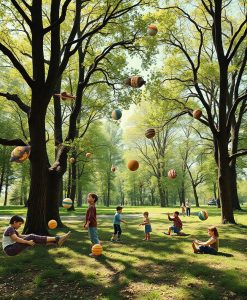Imagine the gentle sway of young leaves on a freshly planted sapling, the soft rustling that carries a whisper of renewal. When you walk past a newly planted row of trees, there’s a subtle sense of hope in the air—a feeling that something new is beginning, not just in the landscape but in the very fabric of life. For many parents and expecting families living near these green guardians, this isn’t just a poetic image; recent research suggests a profound connection between the presence of new trees and the health of newborns.
Living close to greenery has long been associated with better health outcomes, especially when it comes to childbirth. The idea that parks and mature trees can support healthier birth outcomes is familiar—more oxygen, cleaner air, reduced stress. But what if the benefits go even deeper? What if the act of planting new trees, those young saplings just taking root, can positively influence the health of the tiniest members of our communities, even after accounting for socioeconomic factors like income or education?
The new data shines a light on this very question, revealing that newborns living near newly planted trees tend to be healthier—regardless of whether their families are well-off or have access to premium healthcare. This points to a remarkable possibility: that the act of planting trees itself, the ongoing process of greening urban spaces, can foster healthier pregnancies and healthier babies in ways we’re just beginning to understand.
So, how does this happen? Think about the sensory experience of walking through a neighborhood dotted with young trees. The fresh, earthy scent of newly disturbed soil, the vibrant green of tender leaves, the feeling of a gentle breeze—these are more than just pleasant sights and smells. They may influence the environment in ways that support maternal health. For example, trees help filter pollutants from the air, which can reduce inflammation and stress for expectant mothers. They also provide a calming visual cue, lowering anxiety levels during pregnancy, which research suggests, can directly impact birth outcomes.
But there’s more—these findings hint at a subtle, yet powerful, benefit of community investment in green spaces. It’s not just about the trees themselves but what they symbolize: growth, nurturing, and new beginnings. When communities prioritize planting and caring for new trees, they foster environments that support the health of their most vulnerable members—newborns.
If you’re a parent or caregiver wondering how to create a healthier environment for your family, consider the impact of green spaces, especially newly planted trees. These young trees represent a commitment to ongoing growth and health, offering a fresh breath of life that can ripple through generations. Urban planning and community efforts that focus on planting new trees aren’t just beautification—they’re a vital piece of the puzzle for healthier pregnancies and stronger, more resilient communities.

In the end, this research reminds us that the health of our children can be rooted in simple acts—like planting a tree. It’s a quiet but powerful gesture that nurtures the earth and the next generation simultaneously.
Feeling the Breath of New Life: How Trees Nurture Our Babies
Abstract: The link between proximity to greenspace — including trees and parks— and healthy birth outcomes is well established. Now new data adds to our understanding of these health benefits, accounting for other factors that may influence this link, such as education, income and body mass index, but also taking the body of knowledge a step further by exploring the effect of residing near newly planted trees.


